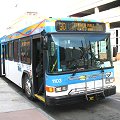- By Patty Poist
- Around Town
 Print
Print  TCAT, Inc. reported Monday that year‑to‑date ridership was up 9.7 percent in the first quarter of 2013 with more than 1.19 million trips compared to nearly 1.09 million trips in the first three months of last year.
TCAT, Inc. reported Monday that year‑to‑date ridership was up 9.7 percent in the first quarter of 2013 with more than 1.19 million trips compared to nearly 1.09 million trips in the first three months of last year.Meantime, year‑ to‑date ridership for April, 2013, was up 11.6 percent with nearly 468, 000 trips compared to a little more than 419,000 trips in the same month last year.
TCAT General Manager Joe Turcotte said this year’s ridership increases come on the heels of TCAT’s 2012 record‑breaking year with nearly 4.13 million annual trips or a 4.7 percent increase over nearly 3.95 million annual trips in 2011.
“TCAT’s consistent ridership increases have become the norm rather than the exception for more than six consecutive years,” Turcotte said. “Yes, it is great news, but it also heightens TCAT’s challenge to find the necessary funding to maintain and build a stronger system to meet that increasing demand from a community that clearly embraces public transit.”
 * The 19.5 percent increase in January was partially due to an earlier start of spring semester classes at Cornell University as compared to 2012, Yarrow noted.
* The 19.5 percent increase in January was partially due to an earlier start of spring semester classes at Cornell University as compared to 2012, Yarrow noted.TCAT Service Analyst Matt Yarrow said it is difficult to explain the increases precisely without a scientific and well‑designed passenger survey, but he offered up a number of factors that likely contributed to the ridership increases.
- There was a significant spike in local gas prices occurring in February and March of 2013. In nearby Syracuse, retail gas prices rose from $3.58 in late December 2012 to close to $3.94 in late February 2013. The county’s gas prices tend to be somewhat higher than Syracuse. When gas prices increase rapidly and combined with other increasing costs associated with single‑vehicle travel – such as parking fees – passengers tend to shift to the transit mode. (Yarrow noted that even though gas prices eased in April, ridership still increased last month.)
- Researchers have shown that young people are at the leading edge of a national trend of decreasing car miles traveled; from 2001 to 2009 the average annual vehicle miles traveled by 18-34 year-olds dropped 23 percent. Given that Tompkins County is host to Cornell University, Ithaca College and Tompkins Cortland County Community College with large numbers of young people, it is likely that this trend toward less car miles is playing out locally, contributing to increased transit ridership.
- Winter 2013 in Ithaca was relatively cold (for example, March 2013 was 1.9° F colder than average and 14.7° F colder than March 2012) which provides an incentive to people that commute by foot or bike to ride the bus.
“TCAT continues to provide excellent transit service and personalized customer service,” Yarrow said in his analysis. “Furthermore, TCAT works with the City of Ithaca, Tompkins County, the universities and community groups to promote transit as an inexpensive, environmentally-friendly transportation option. In general, people in our community respect and value TCAT as a community asset and this in turn can contribute to ridership increases.”
v9i19



